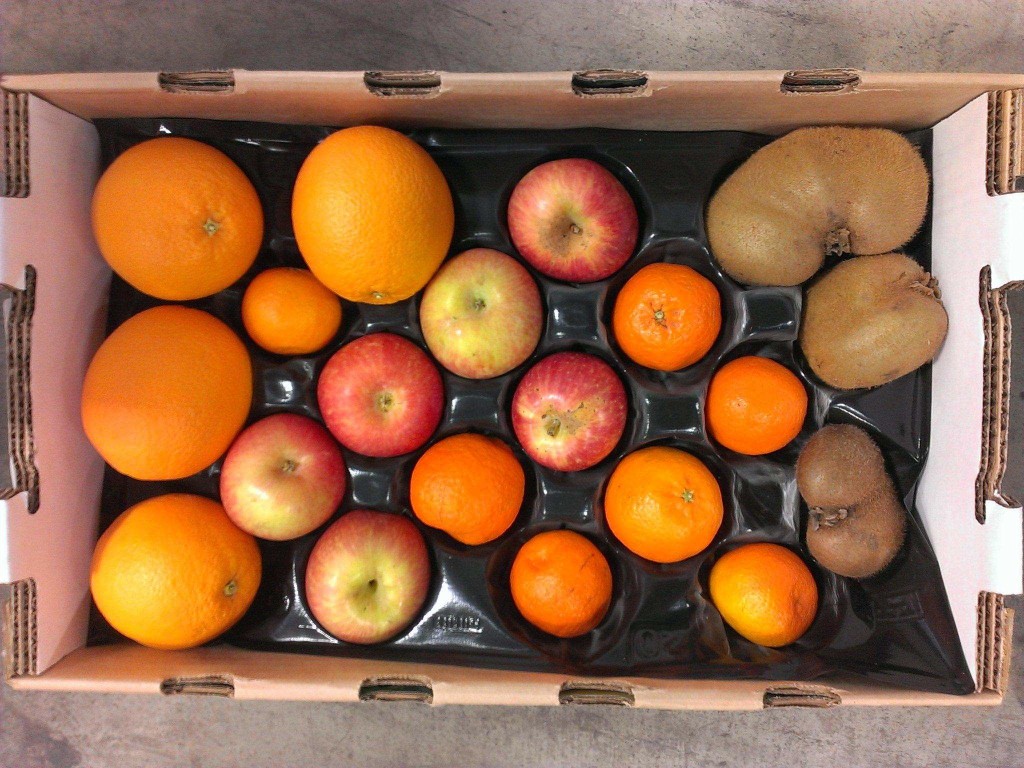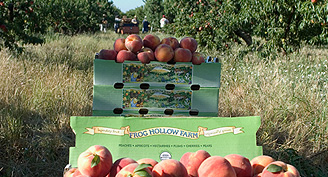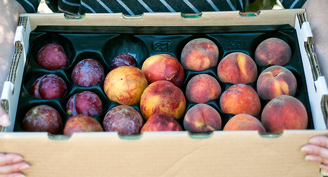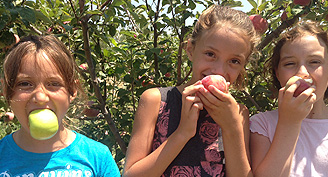THIS WEEKS FRUIT
 Hayward Kiwi
Chieci Farm, Live Oak, CA
Hayward Kiwi
Chieci Farm, Live Oak, CA
Originally known as the Chinese gooseberry due to its Chinese origins. Hawyward Wright, a New Zealand nurseryman propagated his plants by grafting. They eventually became the preferred cultivar of growers due to their sweet flavor and thin skin.
Ready to eat when they yield to gentle pressure. Store these on the counter for 4-5 days. Refrigerate for up to two weeks.
Fuji Apples
Cayuma Orchards, New Cayuma, CA
Fujis are a cross between Red Delicious and Ralls Janet, an heirloom apple dating back to Thomas Jefferson. Fujis are loved by many for their crisp, sweet, and juicy character.
Store on your counter out of direct light for 4-5 days. Refrigerate after to maintain crispness.
Clementine Mandarins
Olsen Organic Farm, Lindsay, CA
Clementines are very sweet, juicy, easy to peel and usually seedless, making them very popular with children and adults alike.
Store out of sunlight for 2-4 days on the counter or up to two weeks in the fridge.
Navel Oranges
Twin Girl, Yettem, CA
California Navel Oranges are considered to be the best Navels for eating out of hand. They have a thick skin that is easy to peel, are seedless, and have a meaty and sweet flesh that makes them a perfect snack. Navels are also great for juicing and cooking.
Store out of sunlight for 2-4 days on the counter or up to two weeks in the fridge.
A NOTE FROM FARMER AL
Dear CSA Members,
“Cover crops” are plants grown on farms to cover the ground, as opposed to plants which are grown for food. There are literally hundreds, if not thousands of plant species which are used for cover crops, and over the past hundred years or so they’ve all been extensively researched by universities across the nation to discover their benefits, and how to manage them to achieve those benefits.
Over the years here at Frog Hollow Farm we have used cover crops from time to time for various reasons, with varying degrees of success. In recent years we’ve practiced the “laissez-faire” cover crop strategy which is the easy way... just let grow whatever grows... we call it "volunteer" cover crop. The values of cover crops are legion! I will mention here only a few:
1. Prevent erosion by wind or by water 2. Add organic matter to the soil 3. Aerate the soil 4. Improve water penetration into the soil 5. Improve habitat for all types of microbes in the soil, such as bacteria, fungi, nematodes, protozoa, etc.
6. Provide habitat for native pollinators 7. Provide habitat for beneficial insects, which will then be available to perform the valuable service of counter-acting the problem insects. 8. Legumes are cover crops (like clovers) which fix nitrogen in the soil.
The list of benefits goes on and on. However, choosing the right mix of cover crops is a whole science unto itself, and requires careful management on the part of the farmer and his crews. And like everything in agriculture, the weather will play a powerful role in the desired outcome.
So we are now planning to intensify our use of cover crops because we now have very important resources: Dr. Gordon Franke of U. C. Berkeley and Christophe Kreis, our compost-meister. We will keep you informed as we develop our cover crop program over the next several years.
 Hayward Kiwi
Chieci Farm, Live Oak, CA
Originally known as the Chinese gooseberry due to its Chinese origins. Hawyward Wright, a New Zealand nurseryman propagated his plants by grafting. They eventually became the preferred cultivar of growers due to their sweet flavor and thin skin. Ready to eat when they yield to gentle pressure. Store these on the counter for 4-5 days. Refrigerate for up to two weeks.
Fuji Apples
Cayuma Orchards, New Cayuma, CA
Fujis are a cross between Red Delicious and Ralls Janet, an heirloom apple dating back to Thomas Jefferson. Fujis are loved by many for their crisp, sweet, and juicy character. Store on your counter out of direct light for 4-5 days. Refrigerate after to maintain crispness.
Clementine Mandarins
Olsen Organic Farm, Lindsay, CA
Clementines are very sweet, juicy, easy to peel and usually seedless, making them very popular with children and adults alike. Store out of sunlight for 2-4 days on the counter or up to two weeks in the fridge.
Navel Oranges
Twin Girl, Yettem, CA
California Navel Oranges are considered to be the best Navels for eating out of hand. They have a thick skin that is easy to peel, are seedless, and have a meaty and sweet flesh that makes them a perfect snack. Navels are also great for juicing and cooking. Store out of sunlight for 2-4 days on the counter or up to two weeks in the fridge.
Hayward Kiwi
Chieci Farm, Live Oak, CA
Originally known as the Chinese gooseberry due to its Chinese origins. Hawyward Wright, a New Zealand nurseryman propagated his plants by grafting. They eventually became the preferred cultivar of growers due to their sweet flavor and thin skin. Ready to eat when they yield to gentle pressure. Store these on the counter for 4-5 days. Refrigerate for up to two weeks.
Fuji Apples
Cayuma Orchards, New Cayuma, CA
Fujis are a cross between Red Delicious and Ralls Janet, an heirloom apple dating back to Thomas Jefferson. Fujis are loved by many for their crisp, sweet, and juicy character. Store on your counter out of direct light for 4-5 days. Refrigerate after to maintain crispness.
Clementine Mandarins
Olsen Organic Farm, Lindsay, CA
Clementines are very sweet, juicy, easy to peel and usually seedless, making them very popular with children and adults alike. Store out of sunlight for 2-4 days on the counter or up to two weeks in the fridge.
Navel Oranges
Twin Girl, Yettem, CA
California Navel Oranges are considered to be the best Navels for eating out of hand. They have a thick skin that is easy to peel, are seedless, and have a meaty and sweet flesh that makes them a perfect snack. Navels are also great for juicing and cooking. Store out of sunlight for 2-4 days on the counter or up to two weeks in the fridge.







